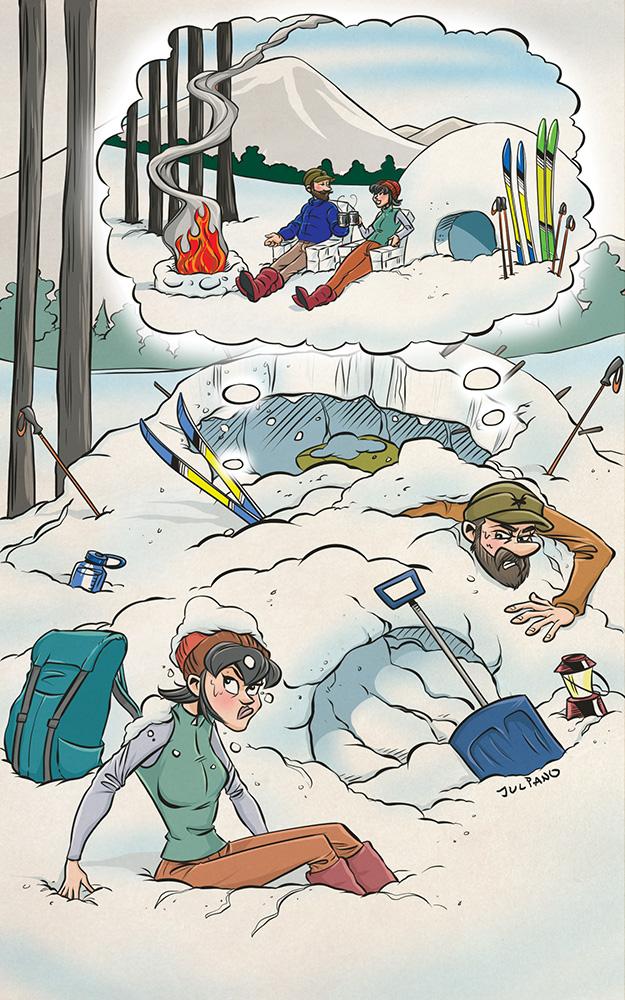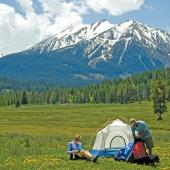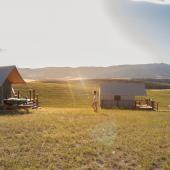Dream vs. Reality: Winter Camping
How great is it, actually?
Rocky Mountain winters are both beautiful and brutal—and if there’s one way to prove you can embrace both, it’s by abandoning all modern amenities, venturing out into the unforgiving elements, and spending the night. If you can do that, then what can’t you do? What else do you need to be able to do? Winter camping is the Holy Grail of human resilience and the measure of a true Montana man or woman. But simply romanticizing about the Jeremiah Johnson lifestyle is a far cry from actually carrying it out. Let’s see how the dream matches up to reality.
Dream
Sunbeams sparkle through green spruce branches as you glide up the skintrack. At first, you were reluctant to agree to a multi-day ski expedition, but now you’re glad you did. It feels good to move outside. Comfortably cool, you climb gentle foothills that spill into a beautiful amphitheater of peaks, ridgetops, and couloirs. Mid-afternoon, you reach the base of a ridge you plan to ski the next day and discover a heap of powder in an excellent spot for a snow cave.
The two of you start shoveling and the quinzhee takes shape in no time. Snow is light and the work is quick. Working in the afternoon sun feels nice—hot, actually. After 45 minutes of digging, just when your arms are starting to tire, your partner crawls out from inside the cave with a toothy grin. She looks ready!
You bundle up in a cozy puffy and build a warm bonfire as the sun sets. Your mate surprises you with whiskey and you sip hot drinks while giddily scouting lines you’ll ski in the morning. This is great. Crawling into bed, you can’t help but notice the top-notch quality of the shelter you’ve constructed. The door is low, with room to sleep on either side of it—it’s the perfect balance of elbow room and body warmth. You feel competent and capable. You are competent and capable—ready for whatever life throws at you. You’ve proven winter worthiness. What a life!
Reality
Wind howls through the treetops, depositing innumerable small branches on the skintrack ahead of you. Slogging awkwardly through the dark canyon, you move at snail’s pace. You pull over to rest and let some body heat dissipate, and even though you’re nowhere close to where you’d hoped to be, you decide to make camp for the night. The wind and below-freezing temperature quickly turn your sweat into frigid water droplets, and you start to shiver. Your mate reminds you of the dinner party you’re both missing in order to freeze your asses off in the snow.
You begin to build a snow cave, but after an hour of digging, the roof collapses for the third time. You can barely feel your fingers and wonder if hypothermia is setting in. In a panic, you rush around to gather wood, but can’t find anything dry. Somehow, you manage to get some moss burning. For a moment, as your fire comes to life, you feel like things are turning the corner. But the wind blows the flames sideways and you retain no heat.
While fumbling with the tent poles, your mate asks about that flask you stashed in your pack. You reach for it, only to discover that the entire thing spilled in your backpack. Crawling into your wet sleeping bag, you regret thinking any part of this was a good idea. What’s left of your confidence is shattered when your GPS shows that you didn’t even make it halfway to the basin. There will be no skiing tomorrow. As you reach across the tent in solidarity, your mate turns away from you. It’s the longest, coldest night of your life.













